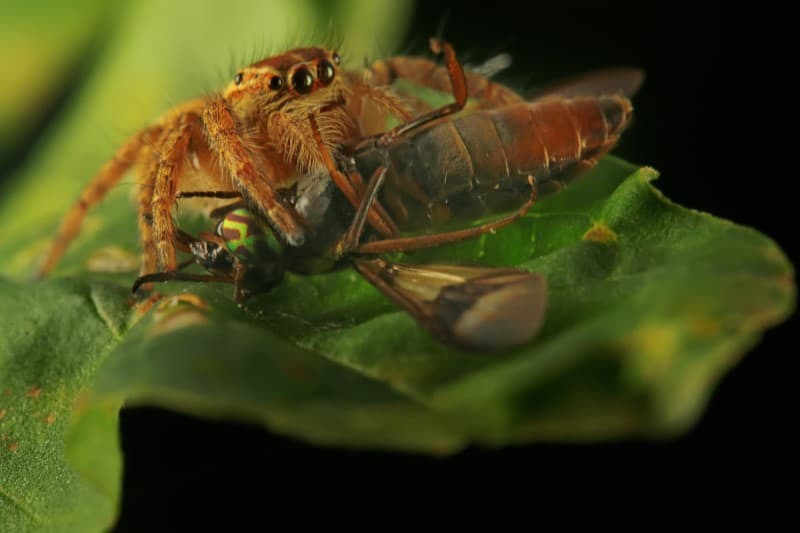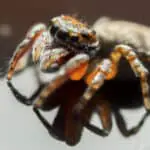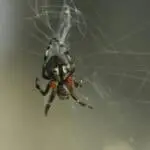Different spiders have individual food preferences; however, most are predators and hunt down insects and other spiders. Typically, there are carnivorous and vegetarian spiders. Thanks to their powerful jaws, fangs, and modified mouthparts, they can quickly attack and grasp their prey.
Unlike what some people believe, spiders do not consider humans as food sources. Secondly, spiders are picky eaters and care about hygiene. Therefore, they will only eat live prey or dead animals that they killed.
We have more exciting details about the spiders’ diet. Take a look at these mind-blowing facts.
Also read: Can You Keep a House Spider as a Pet

Do Spiders Eat Flies?
If you want to get rid of flies in your home, the spiders will do the job for you. Some owners let house spiders live in their households because they help reduce the pest population. Flies are a staple part of the spiders’ diet, and species like the cobweb, wolf, and jumping spiders love hunting them down. It is easy for the clumsy fly to get trapped in the spider’s web. Similarly, there are fast spiders that effortlessly attack unsuspecting insects around.
Instead of feasting on it immediately, spiders “preserve” their catch. As soon as they grasp a fly in their jaws or limbs, they spin a web and wrap it around the flesh. On a good day when it catches many insects, spiders hang up the surplus food to eat when they need to or during scarcity. The web keeps the food fresh and safe for the spiders’ future use, just like humans keep their food refrigerated.
Do Spiders Eat Praying Mantis?
The praying mantis is famous for its excellent hunting skills; it is not easy for a prey in its line of vision to escape unscathed. They have a head that can rotate to 180 degrees and potent limbs and jaws. Thus, it is fascinating to discover that the praying mantis can fall prey to other insects, especially the spider. If a mantis gets entangled in a spider’s web, there are few chances of escaping. Generally, spiders can eat praying mantises as long as they have the size advantage.
The duel between a spider and a mantis can go either way, depending on who is more prominent. The bloody battle always favors the stronger one and the one with better hunting skills. It means that a mantis can also devour a tiny spider when they cross paths. The most prolonged battles are usually between mantises and tarantulas since they are generally the same size. Hence, the better hunter usually wins. The only particular mantis enemy is the giant hornet. It is enormous and at around 2 inches long and has impressive stingers, enough to bring down most insects.
Although the mantis finds it easy to devour small insects, it still has to be cautious when dealing with particular spider species. Some like the widow spider and the funnel-web are famous for their deadly venom. With these spiders, the mantis usually attacks the rear end while avoiding the venom sacs. Consequently, the spider will become immobile due to the exoskeleton’s rapture, giving the mantis the upper hand. Both creatures are incredible hunters; therefore, they feed on each other, with the bigger one having the advantage.
Do Spiders Eat Roaches?
Spiders will eat a bug as long as it is tiny and easy to catch. Depending on the species, spiders can hunt down or build a web to trap roaches. The only downside is that roaches breed in large numbers and are generally faster than the spider. Some homeowners introduce house spiders in their homes and allow them to stay when there is a roach infestation. It is pretty effective in reducing the population, although it may not eliminate all of them. Roaches are great breeders and grow in large numbers over a short time.
Roaches, especially the red runners, are a favorite spider prey because they are soft and fatty, providing plenty of proteins. Their speed is also a plus because the running triggers the predatory response. They also emit an enticing scent that makes it easier for spiders to track them down. The Dubai roach is another preferred insect, thanks to its large body. These roaches are best for giant spiders like the tarantulas, which can effortlessly overpower them. The only problem with the giant roaches is that they are thick, have a hard exoskeleton, and high chitin content, making them viable for massive spider species.
You will notice that the spiders are pretty picky with what they eat; thus, some will refuse to feed on some roach species. However, the decision significantly relies on the roach’s size; miniature spiders find it tasking, if not impossible, to hunt down and eat large cockroaches. It is challenging to overpower a giant prey or even break into its thick chitin-filled shell.
Do Spiders Eat Worms?
Earthworms fall prey to many predatory species, which probably explains why they hide for long under burrows. Although most spiders love feeding on insects, some, like the wolf species, eat worms and other small invertebrates. Generally, there are few accounts of spiders eating earthworms since they rarely cross paths. Spiders do not dig out burrowing creatures like other predators because their limbs are not fit for that. However, a spider is likely to attack it if the worm suddenly emerges from its hideout or if you provide it as live food.
Provided that it is available, spiders feed on most tiny creatures they come across. Some owners even feed their spiders with mealworms. These worms are readily available since they are affordable. You only need to consider their sizes and provide ones that are smaller than your spider. The best live food should be 30-50 percent of your pet’s size. Only large spider species like the tarantulas can feast on giant worms. On the other hand, Wolf species find it easier to attack prey that is approximately 40 percent of its size.
Do Spiders Eat Bees?
Primarily, there are two types of spiders; ambush predators and those that wait for prey to get trapped in webs. Bees are usually the spider’s victims since they are easy to find among the flowers as they pollinate. There are specific species like the crab and jumping spiders that are the biggest threats to the bees. Given that they cannot spin webs to help them hunt, they have to use other tactics. Lying patiently inside flowers, they wait for the bees to show and immediately attack. They even use camouflage and can wait days before they succeed.
When the chance arises, the spider attacks the bee then injects venom. However, it is not a mean fete. Besides the long waiting, the spider has to be very fast because it has sharp eyesight and can detect any abnormality. Other non-ambush predators rely on their web to trap prey for them, but bees can get entangled while others escape. The spider still has to be cautious because if it approaches at a wrong angle, the bee can sting. Its best bet is to wrap the bee up and render it immobile first.
Do Spiders Eat Bugs?
Bugs and insects have nutritional value to their predator. Their advantage is that most have minimal fat content; hence, you don’t need to worry about your pet becoming obese. Most spiders eat and scavenge on many insect species because they form the most significant part of their diet. Spiders love eating bugs, especially when they are tiny and easy to catch. It is pretty challenging to hunt giant bugs down, and only giant spiders like the tarantulas can effortlessly attack them.
Hatchlings can forage on dead bugs until they are mature enough to hunt. On the other hand, older spider species easily prey on live bugs because they have the stamina to fight and overpower them. If a prey stumbles on the spider’s web, it will cause vibrations that will trigger the spider’s senses and tell it that there is an intruder. The spider will then respond to the stimuli by restraining the bug using its silk. The next step is to inject the prey with venom and sap nutrients from its body. Giant spiders are also known to devour their meals whole.
An advantage with the bugs is that they are a cheap food source, readily available, and will help you cut feeding costs. Additionally, they contain minerals such as magnesium, zinc, iron, and phosphorus, among other vital minerals necessary for a healthy exoskeleton and nerve system functionality.
Do Spiders Eat Ants?
A few household spiders and other arachnids feed a lot on insects as their staple food. They are also smart enough to know the particular body parts that contain the essential nutrients. Some ants species also eat spiders; hence, you should be careful with the type of ants you let your pet devour. Ants are part of a specific spider’s diet, and, due to their large population, they are easy to find to provide a ready meal.
As most spiders do, arachnids such as the black widow can pounce and prey on ants even without trapping them in their webs. On the flip side, some ants are very aggressive and dangerous to the spiders. For instance, army ants are challenging to grab. Therefore, some tiny spiders have to use other tactics to succeed in hunting them. They have evolved to emulate the ants to blend in with them. The ants may assume that they are part of the colony, and the spider grabs the opportunity to strike. This characteristic allows the spiders to devour the ants without notice and get away with it.
Ant-eating spiders are specific on what parts of their prey they should eat first. Typically, they will start with the most nutritious part: the anterior end, then proceed to the rear body parts if not satisfied. Ants are an excellent protein source, and their nutrients are vital for the spider’s growth and development. Besides, they contain essential minerals that help strengthen the arachnid’s exoskeleton and improve its digestive system. Using live ants as food can guarantee your good pet health and general well-being.
Do Spiders Eat Butterflies?
Flying insects such as butterflies may be hectic for the wingless arthropods to catch and devour. Regardless, spiders have them on their menu and can eat them in all stages i.e eggs, larva, caterpillar, or when mature. Spiders cannot fly; hence, their webs come in handy to catch and trap the flying insect. Others can chase their prey and attack them in the process, and once paralyzed, finds it easy to feast on the butterfly. Generally, spiders find it convenient to eat eggs, larvae, and caterpillars since they are easier to obtain than the mature butterflies, which tend to fly away.
At all stages, butterflies contain safe and sufficient protein amounts for the spider; thus, they are great for their health. Moreover, the proteins harnessed from the butterflies are essential for the spiders as it helps them in web building. The colossal spider species that can eat butterflies whole obtain fiber from them, which aids in bowel movement.
Do Spiders Eat Plants?
Primarily, spiders are known to be insectivorous. Their diet mainly comprises various insects. However, certain species may feed on plants. Findings have it that certain spider species consider plants an additional food source alongside insects. They believe the plants are a tasty treat and occasionally indulge in them. Unfortunately, unlike insects, plants have lower protein amounts which are not enough for the spider’s dietary needs.
Chiefly, spiders prefer pollen grains, but they can draw plant sap from the leaves or eat some spicy parts by inducing digestive enzymes to dissolve them for easy consumption. The species that love eating plants and insects tend to adapt to harsh environments and survive during seasons of extreme scarcity.
Jumping spiders are a good example of plant-eating arthropods, but obtaining sweet sap is not easy because ants also feed on the same. The spiders have to watch out to avoid scuffles and attacks from ant colonies. Unfortunately, research confirms that spiders that entirely depend on plants may fail to molt or become dwarfs. Therefore, the arachnids should only feed on plants as a treat to widen their diet options or when prey is scarce.
Summary
Most spider species are insectivorous creatures that feed on various insects like flies, roaches, bees, and butterflies. They are highly nutritious and provide all the necessary minerals and vitamins that the spider needs. The only rule with most insects is that they have to be non-venomous and smaller. Otherwise, the spider can fall prey instead. We have also noted that some insects occasionally indulge in plants, but it shouldn’t be their sole diet since they find more nutrients from fleshy meals.
Read more:








